Locustellidae is a newly recognized family of
small insectivorous songbirds ("warblers"), formerly
placed in the Old World warbler "wastebin" family.
It contains the grass-warblers, grassbirds, and the Bradypterus
"bush-warblers". These birds occur mainly in Eurasia,
Africa, and the Australian region. The family name is sometimes
given as Megaluridae, but Locustellidae has priority.
The species are smallish birds with tails that are usually long
and pointed; the scientific name of the genus Megalurus
in fact means "the large-tailed one" in plain
English. They are less wren-like than the typical shrub-warblers,
Cettia,
but like these drab brownish or buffy all over. They tend to
be larger and slimmer than Cettia though, and many have
bold dark streaks on wings and/or underside. Most live in scrubland
and frequently hunt food by clambering through thick tangled
growth or pursuing it on the ground; they are perhaps the most
terrestrial of the "warblers".
Among the "warbler and babbler" superfamily
Sylvioidea, the Locustellidae are closest
to the Malagasy warblers, another newly-recognized (and hitherto
unnamed) family; the Black-capped Donacobius, Donacobius
atricapillus
is an American relative. (It isn't going to be easy....) |
Genera
Genus Bradypterus – Megalurid bush-warblers (more
than 20 species; paraphyletic[3])
Genus Elaphrornis – Sri Lanka Bush-warbler
Genus Locustella – grass-warblers (9 species)
Savi's Warbler, Locustella luscinoides
Pallas's Grasshopper-warbler, Locustella certhiola
Middendorf's Grasshopper-warbler, Locustella ochotensis
Lanceolated Warbler, Locustella lanceolata
River Warbler Locustella fluviatilis
Gray's Grasshopper-warbler, Locustella fasciolata
Grasshopper Warbler, Locustella naevia
Styan's Grasshopper-warbler, Locustella pleskei
Japanese Swamp Warbler, Locustella pryeri
Genus Megalurus – typical grassbirds (5 species;
probably polyphyletic)
Genus Schoenicola – wide-tailed grassbirds (2 species;
tentatively placed here)
Genus Cincloramphus – songlarks (2 species; tentatively
placed here)
Several other (usually small or monotypic) genera are suspected
to belong here too:
Genus Bowdleria – fernbirds (1 living species, 1
recently extinct; sometimes included in Megalurus)
Genus Buettikoferella – Buff-banded Bushbird
Genus Chaetornis – Bristled Grassbird
Genus Dromaeocercus – emu-tails (2 species, includes
Amphilais)
Genus Eremiornis – Spinifex-bird
Genus Megalurulus – thicketbirds (5 species) |
| Engelsk |
Norsk |
Latinsk |
| Sakhalin Warbler |
Sakhalinsanger |
Locustella
amnicola |
| Pallas' Warbler |
Starrsanger |
Locustella
certhiola |
| Gray's Warbler |
Urtesanger |
Locustella
fasciolata |
| Eurasian River Warbler |
Elvesanger |
Locustella
fluviatilis |
| Lanceolated Warbler |
Stripesanger |
Locustella
lanceolata |
| Savi's Warbler |
Sumpsanger |
Locustella
luscinioides |
| Grasshopper Warbler |
Gresshoppesanger |
Locustella
naevia |
| Middendorff's Warbler |
Okhotsksanger |
Locustella
ochotensis |
| Pleske's Warbler |
Engsanger |
Locustella
pleskei |
| Locustfinch |
Gresshoppeastrild |
Paludipasser
locustella |
Eurasian
River Warbler, No: Elvesanger, Locustella fluviatilis
UK: River Warbler DE: Schlagschwirl FR: Locustelle fluviatile ES:
Buscarla Fluvial CZ: Cvrcilka rícní DK: Flodsanger NL:
Krekelzanger FI: Viitasirkkalintu IT: Locustella fluviatile NO: Elvesanger
SE: Flodsångare RU: ?????? ??????? JP: ??????? AR: ???? ???????
GR: ??taµ?t????st?? PT: Felosa-fluvial UA: ??????? ?????????
AF: Sprinkaansanger TR: Agaç Kamisçini SK: Svrciak riecny
LV: Upes kaukis EE: Jogi-ritsiklind PL: Strumieniówka HU: Berki
tücsökmadár
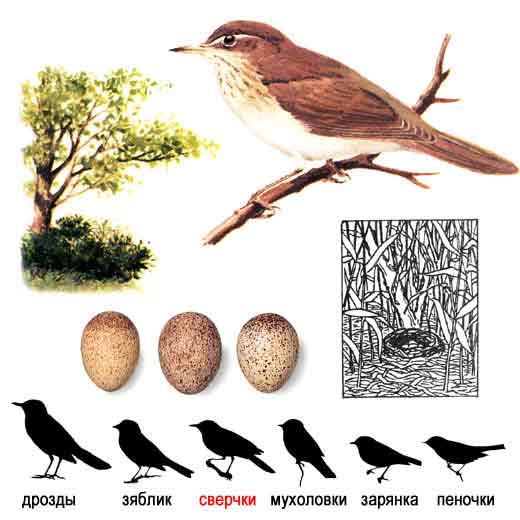 Eurasian
River Warbler, Locustella fluviatilis
Eurasian
River Warbler, Locustella fluviatilis
© http://www.ecosystema.ru/
The River Warbler, Locustella fluviatilis,
is an Old World warbler in the grass warbler genus Locustella.
It breeds in east and central Europe into western Asia. It is
migratory,
wintering in east Africa.
This small passerine bird is a species found in dense deciduous
vegetation close to water in bogs or near a river.
5-7 eggs are laid in a nest in a tussock or on the ground. This
species is a rare vagrant to western Europe.
In Britain, a small number of males have set up territories
in spring, including a bird in Greater Manchester in 1995. |
 Singing
River Warbler
Singing
River Warbler
Photo: http://en.wikipedia.org/wiki/File:Flodsangare.jpg
This is a largish warbler. The adult has an unstreaked grey-brown
back, whitish grey underparts, and a darker
undertail, which has white feather tips giving a contrasting
pattern. The sexes are identical, as with most warblers,
but young birds are yellower below. Like most warblers, it is
insectivorous.
Some birds can show reduced dark markings on the undertail-coverts
(caused by more extensive than usual
white tips) and thus be closer in appearance to Savi's Warbler
than typical birds; however they typically still have
a streaked breast and more olive upperparts coloration. |
 Eurasian
River Warbler, Locustella fluviatilis
Eurasian
River Warbler, Locustella fluviatilis
© Lubomir Hlasek, http://www.hlasek.com
This is a skulky species which is very difficult to see except
sometimes when singing.
It creeps through grass and low foliage.
The song is a monotonous mechanical insect-like reeling, often
given at dusk. It is similar to the song of a
Grasshopper Warbler, but has more of a
sewing machine quality, and may be produced for long periods. |
Grasshopper
Warbler, Locustella naevia
 Grasshopper
Warbler, Locustella naevia
© http://www.ecosystema.ru/
Grasshopper
Warbler, Locustella naevia
© http://www.ecosystema.ru/
The Grasshopper Warbler, Locustella naevia,
is an Old World warbler in the grass warbler genus Locustella.
It breeds across much of temperate Europe and Asia. It is migratory,
wintering from northwest Africa to India.
This small passerine bird is a species found in short dense
vegetation, often close to water.
4–7 eggs are laid in a nest on the ground or a tussock. |
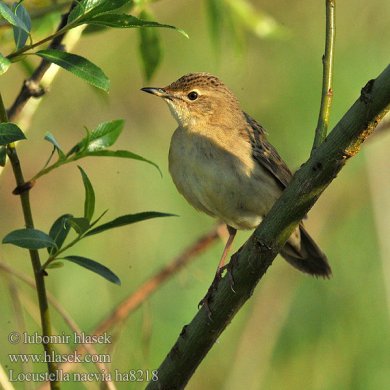 Grasshopper
Warbler, Locustella naevia
Grasshopper
Warbler, Locustella naevia
© Lubomir Hlasek, http://www.hlasek.com
This is a medium-sized warbler, 12.5–13.5
cm long. The adult has a streaked brown back, whitish grey underparts,
unstreaked except on the undertail. The sexes are identical,
as with most warblers, but young birds are yellower below. Like
most warblers, it is insectivorous.
This is a skulking species which is very difficult to see except
sometimes when singing.
It creeps through grass and low foliage.
The song, which gives this species its name, is a monotonous
mechanical insect-like reeling, often given at dusk. |
 Grasshopper
Warbler, Locustella naevia
Grasshopper
Warbler, Locustella naevia
© Josef Hlasek, http://www.hlasek.com
Pallas's
Grasshopper-warbler, Locustella certhiola
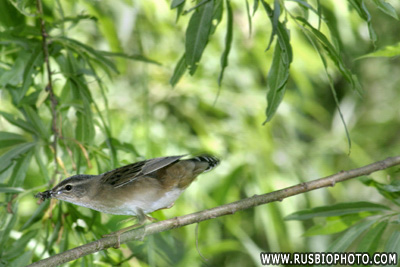
Pallas's
Grasshopper-warbler, Locustella certhiola - 2006,
Russia Krasnoyarsk Region
©
www.ecosystema.ru/
The Pallas's Grasshopper Warbler, Locustella certhiola,
is an Old World warbler in the grass warbler
genus Locustella. It breeds in east Asia. It is migratory,
wintering from India east to Indonesia.
This species is a very rare vagrant to western Europe. One of
the best places to see this skulking species as a vagrant is
Fair Isle, Shetland; for a species that only rarely appears
in western Europe, it can be found there with some regularity.
This has made it a sought after species among UK "twitchers".
|
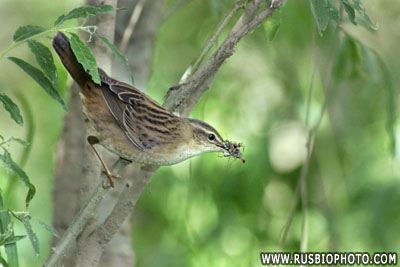
Pallas's
Grasshopper-warbler, Locustella certhiola - 2006,
Russia Krasnoyarsk Region
©
www.ecosystema.ru/
|
This small passerine bird is a species found in tall grass
with some thicker vegetation, usually close to water in
bogs or wet meadows. From 4 to 7 eggs are laid in a nest on
the ground in grass.
This is a medium-sized warbler. The adult has a streaked brown
back, whitish grey underparts, unstreaked
except on the undertail. The sexes are identical, as with
most warblers, but young birds are yellower below.
Like most warblers, it is insectivorous. It is very similar
to the Grasshopper Warbler, but
is slightly larger,
has white tips to the tail and tertial feathers, and a warmer
brown rump. The white tips are the reason for its
colloquial, mnenomic name of "PG Tips".
This is a skulky species which is very difficult to see except
sometimes when singing. It creeps through grass
and low foliage.
The song is not the mechanical insect-like reeling produced
by the Grasshopper Warbler and
some other Locustella warblers, but an inventive Acrocephalus-like
melody.
This bird was named after the German zoologist Peter Simon
Pallas.
|
Savi's
Warbler, No: Sumpsanger, Locustella luscinioides
UK:
Savi's Warbler DE: Rohrschwirl FR: Locustelle luscinioïde ES:
Buscarla Unicolor CZ: Cvrcilka slavíková DK: Savisanger
NL: Snor FI: Ruokosirkkalintu IT: Salciaiola NO: Sumpsanger SE: Vassångare
PT: Felosa-unicolor UA: ?????'??? ????????? TR: Bataklik Kamisçini
HR: Veliki cvrcic LT: Nendrinis žiogelis LV: Seivi kaukis EE:
Roo-ritsiklind HU: Nádi tücsökmadár PL: Brzeczka
RO: Grelusel de stuf SK: Svrciak slávikovitý SI: Srpicna
trstnica SI: Obican cvrcic Obicni
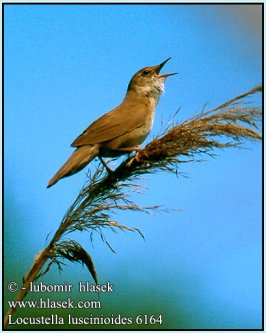 Savi's
Warbler,
Locustella luscinioides
Savi's
Warbler,
Locustella luscinioides
© Lubomir Hlasek, http://www.hlasek.com
 Savi's
Warbler,
Locustella luscinioides
Savi's
Warbler,
Locustella luscinioides
© Lubomir Hlasek, http://www.hlasek.com
|

















